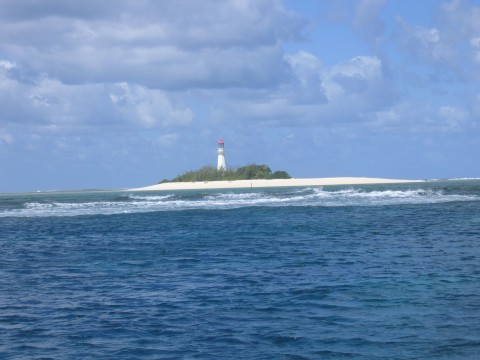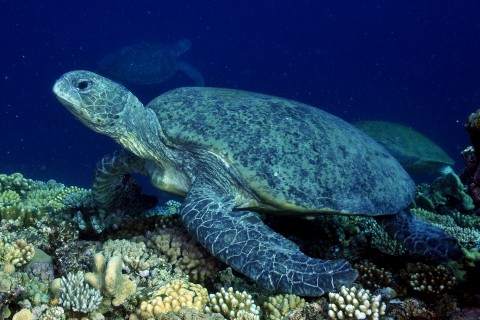Dump the kids and take off

The coral reef islands on the southern GBR are a great place to start a family. But after the nesting season is over many of the animals that breed on the islands, swim or fly far away. Tracking devices on turtles and seabirds that nest in the region around Heron Island on the southern Great Barrier Reef (GBR) are recording the journeys of the animals as they travel across the ocean.
Dr Col Limpus has been tracking turtles using flipper tags for more than 40 years as part of the Queensland National Parks turtle tagging program. Thousands of turtles have been tagged while nesting on the beaches of Great Barrier Reef islands and beaches and the wealth of data he has collected has made it possible to measure where, when, and how far individuals were actually migrating. Tag recoveries from the islands in the Capricorn-Bunker group of reefs show that after nesting, turtles some make short migrations up the coast while others make the long ocean crossing to New Caledonia 1.
Turtles are known to return to the region where they were hatched to lay their eggs but the mechanisms that enable natal homing or that influence trans-ocean migrations are not understood. Factors including abundance and proximity of food sources, ocean currents and earth’s geomagnetic field and reinstatement of passive drift experienced by hatchlings have been put forward as being causal factors. However none provide good explanations for the pattern of tag recovery observed in the southern GBR green turtles 1. The need for a more complete picture of the lifecycle can be triggered as part of cultural, economic, political, and legal negotiations to manage vulnerable species over international boundaries 2 or by biological events such as unexplained declines in breeding success, as for example has been observed in the northern stock of green turtles on the GBR.
A decline in fledgling success in wedge-tailed shearwaters, a seabird that nests on Heron Island was the trigger for Dr Brad Congdon and his research team from James Cook University to investigate the bird’s feeding ecology. He said breeding pairs of shearwaters take it in turns to look after their chick. Relative to sites further offshore, food availability near the island is low and the adult that forages near the island feeds the chick nearly all that it catches. The other adult travels further in search of food to rebuild its own reserves, routinely travelling up to 1000km to foraging grounds in the Coral Sea. The adults then swap jobs every 8 to 10 days.
Shearwater tracks recorded using satellite telemetry. To access the map page click on the 4-arrow square.
Metadata The shaded areas show the Biological Important Areas for seabirds in the Coral Sea (DSEWPaC)
Dr Congdon found the feeding sites were located in areas where oceanographic features increase food availability. He said, “At-distance feeding occurred where there were steep shifts in the sea floor and large-scale oceanographic features such as front and eddies.” The importance of oceanographic features for seabird food availability was first identified by Congdon during the mid 2000s 3, when he was looking for evidence to explain a decline in fledgling success of shearwaters on Heron Island. Lower availability of baitfish, the shearwaters primary food source was found to be a response to a short-term ocean circulation pattern known as a mesoscale eddy. Cold dense oceanic water pushed up onto the reef shelf by the eddy stopped surface waters from mixing and caused them to heat up. The bait fish moved to avoid these warm waters and so became unavailable to the birds 4.
Congdon said in addition to the feeding sites in the Coral Sea, wedge-tailed shearwaters of the GBR are trans-equatorial migrants. During the non-breeding season they overwinter in Micronesia, in a region known globally for its commercial tuna catch rates. Keeping tabs on ocean travellers is tough but tagging technologies are becoming increasingly sophisticated. Telemetry tags getting smaller and their lifespan for sending data increasing. Adding additional sensors like accelerometers that record heart rates provides a very detailed picture of the stresses and windfalls for animals as they move through the environment 5. Whether its trans-ocean migrations or foraging trips close to home, learning more about mobile species and the environmental factors that influence their movements is vital for current conservation management and to help scientists predict how climate change will affect species ranges and connectivity.
1. Read T, Wantiez L, Werry J et al. Migrations of Green Turtles (Chelonia mydas) between Nesting and Foraging Grounds across the Coral Sea. PLoS ONE 2014;9:e100083.
2. Gredzens C, Marsh H, Fuentes M et al. Satellite Tracking of Sympatric Marine Megafauna Can Inform the Biological Basis for Species Co-Management. PLoS ONE 2014;9:e98944.
3. Peck DR, Smithers BV, Krockenberger AK et al. Sea surface temperature constrains wedge-tailed shearwater foraging success within breeding seasons. Marine Ecology Progress Series Inter-Research, 2004;281:259–266. https://eprints.jcu.edu.au/24575/.
4. Weeks SJ, Steinberg C, Congdon BC. Oceanography and seabird foraging: within-season impacts of increasing sea surface temperatures on the Great Barrier Reef. Mar Ecol Prog Ser 2013;490:247–254. https://www.int-res.com/articles/meps2013/490/m490p247.pdf.
5. Costa D, Breed G, Robinson P. New Insights into Pelagic Migrations: Implications for Ecology and Conservation. Annual Review of Ecology, Evolution, and Systematics 2012;43:7396.







